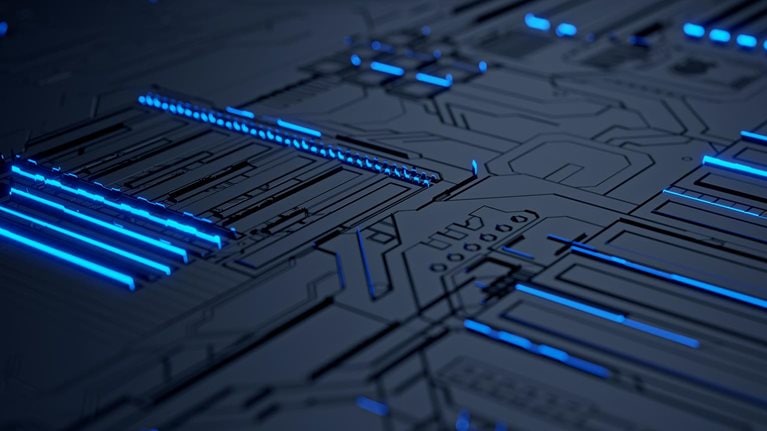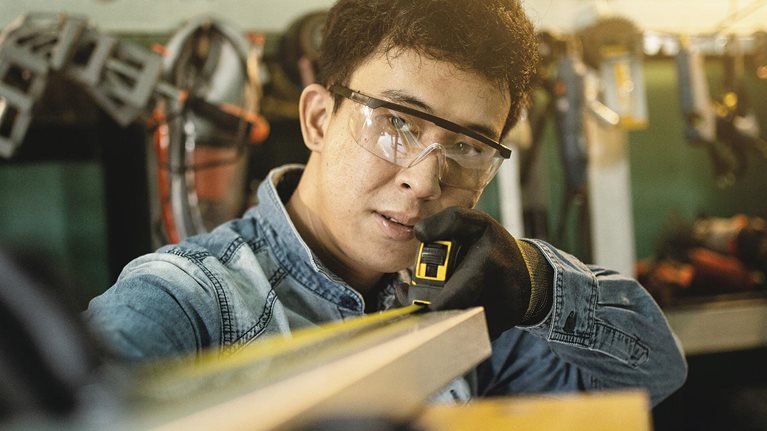In 2018, we explored the $1 trillion opportunity for artificial intelligence (AI) in industrials.1 As companies are recovering from the pandemic, research shows that talent, resilience, tech enablement across all areas, and organic growth are their top priorities.2
Despite this opportunity, many executives remain unsure where to apply AI solutions to capture real bottom-line impact. The result has been slow rates of adoption, with many companies taking a wait-and-see approach rather than diving in.
Rather than endlessly contemplate possible applications, executives should set an overall direction and road map and then narrow their focus to areas in which AI can solve specific business problems and create tangible value. As a first step, industrial leaders could gain a better understanding of AI technology and how it can be used to solve specific business problems. They will then be better positioned to begin experimenting with new applications.
Defining AI
The term “artificial intelligence” is suffering from severe overuse. It has almost become shorthand for any application of cutting-edge technology, obscuring its true definition and purpose. Therefore, it’s helpful to clearly define AI and its uses for industrial companies.
In short, AI is the ability of a machine to perform cognitive functions typically associated with human minds, such as perceiving, reasoning, learning, interacting with the environment, and problem solving. Examples of AI technologies include robotics, autonomous vehicles, computer vision, language, virtual agents, and machine learning.
One area in which AI is creating value for industrials is in augmenting the capabilities of knowledge workers, specifically engineers. At their core, such applications harness AI’s predictive capabilities. Companies are learning to reformulate traditional business issues into problems in which AI can use machine-learning algorithms to process data and experiences, detect patterns, and make recommendations.
How AI can accelerate problem solving
Companies must first define an existing business problem before exploring how AI can solve it. Failure to go through this exercise will leave organizations incorporating the latest “shiny object” AI solution.
The following examples demonstrate AI’s value in augmenting workers’ knowledge and streamlining workflows.
AI scheduling agents
Some of the most difficult challenges for industrial companies are scheduling complex manufacturing lines, maximizing throughput while minimizing changeover costs, and ensuring on-time delivery of products to customers. AI can help through its ability to consider a multitude of variables at once to identify the optimal solution. For example, in one metals manufacturing plant, an AI scheduling agent was able to reduce yield losses by 20 to 40 percent while significantly improving on-time delivery for customers.
Traditional optimization approaches collapse in an attempt to manage significant uncertainty and fluctuation in supply or demand. This problem has become particularly relevant given all of the supply chain issues over the past year. Using scheduling agents based on reinforcement learning,3 companies can translate this issue into a question—“What order is most likely to maximize profit?”—that yields a clear recommendation.
To solve this problem, companies must first build an environment in which the AI scheduling agent can learn to make good predictions (Exhibit 1). In this situation, relying on historical data (as typical machine learning does) is simply not good enough because the agent will not be able to anticipate future issues (such as supply chain disruptions).

Instead, organizations can start by building a simulation or “digital twin” of the manufacturing line and order book. A scheduling agent can then schedule the line. The agent’s performance is scored based on the cost, throughput, and on-time delivery of products. Next, the agent “plays the scheduling game” millions of times with different types of scenarios. Just as Deep Mind’s AlphaGo agent got better by playing itself, the agent uses deep reinforcement learning to improve scheduling.4 Before long, the agent is able to create high-performance schedules and work with the human schedulers to optimize production.
Knowledge discovery
Many industrial companies face the common issue of identifying the most relevant data when faced with a specific challenge. AI can accelerate this process by ingesting huge volumes of data and rapidly finding the information most likely to be helpful to the engineers when solving issues. For example, companies can use AI to reduce cumbersome data screening from half an hour to a few seconds, thus unlocking 10 to 20 percent of productivity in highly qualified engineering teams. In addition, AI can also discover relationships in the data previously unknown to the engineer.
After decades of collecting information, companies are often data rich but insights poor, making it almost impossible to navigate the millions of records of structured and unstructured data to find relevant information. This challenge is particularly important when engineers are troubleshooting new issues on highly complex systems (for example, aircraft, spacecraft, and power plants) to find the most relevant procedures, machine performance data, history of operations, and instances of relevant issues on similar subsystems. Engineers are often left relying on their previous experience, talking to other experts, and searching through piles of data to find relevant information. For critical issues, this high-stakes scavenger hunt is stressful at best and often leads to suboptimal outcomes.
Companies can teach AI to navigate text-heavy structured and unstructured technical documents by feeding it important technical dictionaries, lookup tables, and other information. They can then build algorithms to help AI understand semantic relationships between different text. Next, a knowledge graph5 can dynamically create an information network that represents all the semantic and other relationships in the technical documents and data (Exhibit 2). For example, using the knowledge graph, the agent would be able to determine a sensor that is failing was mentioned in a specific procedure that was used to solve an issue in the past. Once the knowledge graph is created, a user interface allows engineers to query the knowledge graph and identify solutions for particular issues. The system can be set up to collect feedback from engineers on whether the information was relevant, which allows the AI to self-learn and improve performance over time.

AI-enabled product system design
For many industrial companies, the system design of their products has become incredibly complex. Organizations can use AI to augment a product’s bill of materials (BoM) with data drawn from its configuration, development, and sourcing. This process identifies opportunities to reuse historical parts, improve existing standard work, and support preproduction definition. With these insights, companies can significantly reduce engineering hours and move to production more quickly.
When a single project can have millions of parts and thousands of submodules and subsystems, it can be nearly impossible for any single engineer to have a full systems view as well as an understanding of the detailed design of individual components, let alone across projects. As a result, systems are redesigned with each new project but overlook opportunities to reuse parts, driving up costs and increasing supply chain complexity. In addition, engineers can face significant rework on projects from not fully understanding interdependencies across the system.
Fortunately, AI approaches do not have such limitations. With sufficient memory and computation, AI-based solutions can easily look across millions of parts and projects and billions of relationships to identify opportunities for reuse and sequence processes to avoid rework related to interdependencies. A network-based representation of the system using BoM can capture complex relationships and hierarchy of the systems (Exhibit 3). This information is augmented by data on engineering hours, materials costs, and quality as well as customer requirements. With this enhanced network build, companies can query and make predictions—for example, what subsystems a customer requirement might affect and the engineering efforts that are most likely to cause rework in a project based on interdependencies.

Product performance optimization
As products have evolved, pushing the boundaries of performance has become increasingly challenging. Industrial companies that can rapidly innovate and bring higher-performing products to market faster are much more likely to gain market share and win in their market segments.
Over the past three decades, computer-aided engineering (CAE) and simulation have helped, but the limits on their computing power are preventing them from fully exploring the design space and optimizing performance on complex problems. For example, components typically have more than ten design parameters, with up to 100 options for each parameter. Because a simulation takes ten hours to run, only a handful of the resulting trillions of potential designs can be explored in a week. Companies that rely on experienced engineers to narrow down the most promising designs to test in a series of designed experiments risk leaving performance on the table.
AI uses a deep-learning neural network to create a digital twin of the component and predict performance (Exhibit 4).6 Organizations can also use Bayesian optimizers to predict the most promising areas of the design space to explore.7 Shifting from exact calculations to a directional problem-solving approach focused on predictions exponentially accelerates the evaluation of design. An engine can generate millions of potential designs that are evaluated using the deep-learning digital twin. A genetic algorithm can then optimize the system for multiple performance metrics at the same time (for example, in automotive top speed and fuel economy).

AI-augmented root cause analysis
Industrial companies build their reputations based on the quality of their products, and innovation is key to continued growth. Winning companies are able to quickly understand the root causes of different product issues, solve them, and integrate those learnings going forward. AI can dramatically speed up this process.
Since the complexity of products and operating conditions has exploded, engineers are struggling to identify root causes and track solutions. As a result, companies are highly dependent on pattern recognition by experienced engineers and spend a lot of time trying to re-create issues in lab environments in an attempt to get to the root cause.
AI and causal modeling8 approaches can reformulate this complexity into a defined business problem: “What are the top five most likely root causes for this issue?” Companies can start by building an event-based data model that connects thousands of variables across the product history and development life cycle, including design configurations, manufacturing parameters, and maintenance and repair history. An AI-based model can then identify the top predictors of incidents related to a specific issue (Exhibit 5). Next, causal modeling approaches separate variables that are correlated from those likely to be causal. A user interface enables engineers to query and find the most likely root causes of new issues.

AI is still in relatively early stages of development, and it is poised to grow rapidly and disrupt traditional problem-solving approaches in industrial companies. These use cases help to demonstrate the concrete applications of these solutions as well as their tangible value. By experimenting with AI applications now, industrial companies can be well positioned to generate a tremendous amount of value in the years ahead.


